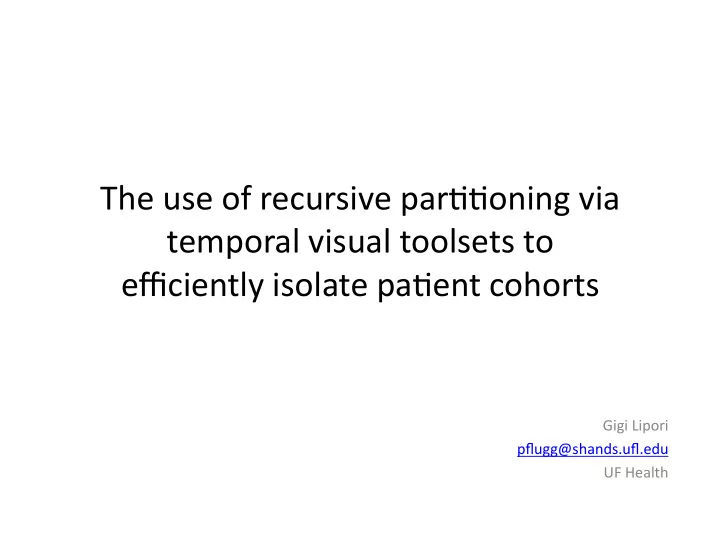

The ¡use ¡of ¡recursive ¡par//oning ¡via ¡ temporal ¡visual ¡toolsets ¡to ¡ efficiently ¡isolate ¡pa/ent ¡cohorts ¡ Gigi ¡Lipori ¡ pflugg@shands.ufl.edu ¡ UF ¡Health ¡
Concept ¡ • Total ¡parenteral ¡nutri/on ¡(TPN) ¡was ¡introduced ¡in ¡the ¡1960’s ¡and ¡ has ¡become ¡vital ¡in ¡the ¡preven/on ¡and ¡reversal ¡of ¡malnutri/on ¡for ¡ individuals ¡with ¡various ¡diseases ¡and ¡condi/ons ¡ • TPN ¡has ¡been ¡linked ¡to ¡mucosal ¡atrophy, ¡reduced ¡GI ¡hormone ¡ secre/on ¡and ¡liver ¡dysfunc/on ¡ • To ¡date, ¡the ¡majority ¡of ¡the ¡informa/on ¡we ¡have ¡on ¡parenteral ¡ nutri/on-‑associated ¡liver ¡disease ¡is ¡based ¡on ¡data ¡from ¡the ¡ pediatric ¡sector ¡and ¡animal ¡models ¡ • The ¡frequency ¡of ¡parenteral ¡nutri/on ¡in ¡adults ¡is ¡on ¡the ¡rise, ¡both ¡ for ¡acute ¡and ¡chronic ¡condi/ons ¡ ¡ • Our ¡aim ¡is ¡to ¡retrospec/vely ¡study ¡adults ¡who ¡received ¡TPN ¡in ¡our ¡ facility ¡to ¡determine ¡the ¡frequency ¡of ¡parenteral ¡nutri/on-‑ associated ¡liver ¡disease, ¡the ¡face ¡the ¡disease, ¡and ¡the ¡severity ¡with ¡ which ¡it ¡presents ¡
Approach ¡ • We ¡began ¡by ¡comple/ng ¡a ¡short ¡look-‑back ¡to ¡gain ¡ experience ¡with ¡a ¡small ¡dataset ¡containing ¡rela/vely ¡few ¡ subjects ¡and ¡dimensions ¡ • By ¡using ¡conven/onal ¡query ¡techniques ¡against ¡ administra/ve ¡and ¡clinical ¡datasets, ¡we ¡easily ¡isolated ¡a ¡set ¡ of ¡4500 ¡adults ¡who ¡received ¡TPN ¡ • We ¡likewise ¡easily ¡isolated ¡a ¡subset ¡of ¡2600 ¡adults ¡who ¡ received ¡TPN ¡and ¡had ¡some ¡indica/on ¡of ¡liver ¡disease ¡ • Now ¡for ¡the ¡hard ¡part ¡– ¡what ¡were ¡the ¡temporal ¡ considera/ons ¡within ¡this ¡subset ¡ ¡ – How ¡many ¡pa/ents ¡had ¡liver ¡disease ¡occur ¡a[er ¡TPN ¡was ¡ introduced? ¡ – What ¡was ¡the ¡progression ¡of ¡their ¡disease? ¡
Demonstra/on ¡ • Let’s ¡load ¡synthe/c ¡data ¡for ¡1K ¡pa/ents ¡(20K ¡ facts) ¡into ¡EventFlow, ¡explore ¡the ¡data, ¡ determine ¡if ¡we ¡can ¡answer ¡our ¡preliminary ¡ research ¡ques/ons, ¡and ¡if ¡we ¡can ¡isolate ¡a ¡ meaningful ¡cohort ¡for ¡the ¡research ¡team ¡ • We’ll ¡use ¡simplifica/on ¡techniques, ¡filter ¡ techniques ¡and ¡transforma/on ¡techniques, ¡ including ¡category ¡aggrega/on, ¡interval ¡ merging ¡and ¡marker ¡events ¡
INTERVAL ¡EVENT ¡ POINT ¡EVENT ¡ POINT ¡EVENT ¡ INTERVAL ¡EVENT ¡ INTERVAL ¡EVENT ¡
INTERVAL ¡EVENT ¡ INTERVAL ¡EVENT ¡
INTERVAL ¡EVENT ¡
Back ¡to ¡Our ¡Research ¡Ques/ons ¡ • How ¡many ¡pa/ents ¡had ¡liver ¡disease ¡occur ¡a[er ¡ TPN ¡was ¡introduced? ¡ ¡ ¡ 180 ¡ • What ¡was ¡the ¡progression ¡of ¡their ¡disease? ¡ • What ¡else ¡can ¡we ¡see? ¡
Conclusion ¡ • EventFlow ¡provided ¡a ¡flexible ¡and ¡robust ¡pladorm ¡ for ¡us ¡to ¡recursively ¡par//on ¡our ¡data ¡and ¡ explore ¡various ¡temporal ¡aeributes ¡ • Alterna/ve ¡tradi/onal ¡techniques ¡would ¡have ¡ required ¡the ¡crea/on ¡of ¡a ¡priori ¡hypotheses ¡that ¡ would ¡have ¡been ¡difficult ¡to ¡code ¡and ¡would ¡have ¡ s/fled ¡the ¡loose ¡explora/on ¡of ¡concepts ¡ • Through ¡this ¡exploratory ¡exercise, ¡we ¡developed ¡ domain ¡specific ¡concepts ¡that ¡will ¡be ¡extensible ¡ to ¡our ¡larger ¡study ¡
Demo ¡Ini/al ¡Load ¡
Demo ¡Search ¡and ¡Replace ¡
Demo ¡Combine ¡Events ¡
Demo ¡Merge ¡Events ¡
Recommend
More recommend